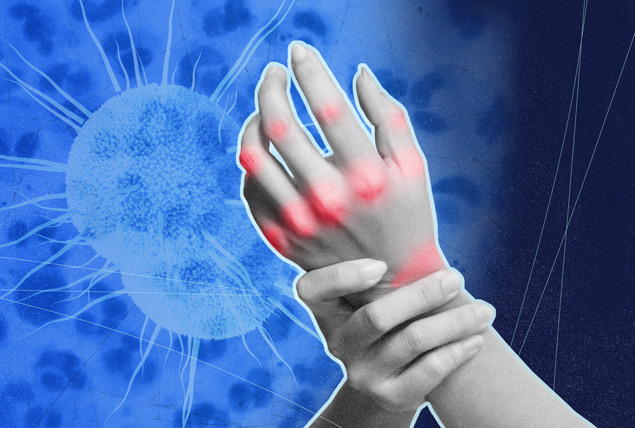Can Gonorrhea Give You Arthritis?

Gonorrhea and arthritis are two of the most prevalent health conditions in the United States, collectively affecting tens of millions of people each year, according to the Centers for Disease Control and Prevention (CDC).
The two are usually unrelated, but in rare cases, a gonorrhea infection can develop into disseminated gonococcal infection (DGI) and gonococcal arthritis. Despite these complications being serious and sometimes life-threatening, they are highly preventable and manageable with early intervention.
What are gonorrhea and arthritis?
To understand the connection, it's helpful to first understand gonorrhea and arthritis independently.
Gonorrhea is the sixth-most common sexually transmitted disease (STD) in the U.S., according to the CDC, and infection rates are rising.
The bacteria responsible for gonorrhea—Neisseria gonorrhoeae (NG)—is transmitted during sex via skin-to-skin contact with an infected person, said Deborah Lee, M.B.Ch.B., a sexual and reproductive health specialist at Dr Fox, an online pharmacy in the United Kingdom.
It can also spread through sex toys contaminated with the bacteria. Neisseria gonorrhoeae invades and reproduces within the mucous membranes of the body, such as those in the genitals, rectum, throat, cervix and eyes. It causes inflammation and symptoms such as:
- Burning pain while passing urine
- Conjunctivitis
- Painful sex
- Pelvic pain
- Urethral or vaginal discharge
Gonorrhea is highly treatable, but if unaddressed it can lead to serious complications, such as infertility.
On the other hand, arthritis is a term referring to more than 100 conditions characterized by joint inflammation and pain. The most common forms of arthritis are rheumatoid arthritis and osteoarthritis. Multiple factors can contribute to arthritis development, including genes, lifestyle, age, occupation, injuries and infections.
Most kinds of arthritis are chronic and incurable but can be managed with a doctor's or physical therapist's help.
Gonorrhea and arthritis are more common in women but can affect anyone.
The connection between gonorrhea and arthritis
Gonococcal arthritis is a kind of septic arthritis that occurs when bacteria from an infection—in this case, Neisseria gonorrhoeae—enter the bloodstream and spread to other parts of the body, mainly the joints.
Gonococcal arthritis is one of the more common manifestations of DGI, explained Michael W. Henry, M.D., an internal medicine and infectious disease specialist at the Hospital for Special Surgery in New York City.
Another is "arthritis-dermatitis" syndrome, which, according to Lee, produces three characteristic symptoms:
- Tenosynovitis (inflammation of the membrane surrounding the tendons)
- Dermatitis (skin inflammation)
- Arthritis
Typically, the latter is a result of a more systemic infection.
"(DGI) is a serious infection which needs proper medical management," Lee said.
Henry noted that because gonorrhea is sexually transmitted, DGI usually spreads from the genitals, anorectal area or mouth.
Women with gonorrhea or DGI can pass the infection to newborns during delivery.
What are the symptoms of gonococcal arthritis?
According to the National Library of Medicine, symptoms in adults and teens include, but aren't limited to, the following:
- A skin rash consisting of raised lesions—macules, vesicles, pustules or skin abscesses—on the trunk, palms and soles, but not the scalp, face or mouth. Usually, these appear pink or red and may later turn purple. They can be quite painful, although some people don't experience any discomfort.
- Fever, chills and a general feeling of sickness.
- Genital symptoms like urethral or vaginal discharge, pain in passing urine or pelvic pain.
- Inflammation in the hands and wrists, which causes pain with movement and tenderness when pressed.
- Inflammation, pain, tenderness and redness in one or more joints, usually the knees, ankles, elbows and wrists. Unlike rheumatoid arthritis, the affected joints typically aren't symmetrical. For example, the right knee and left wrist might be affected, rather than both knees or wrists.
According to information from Mount Sinai, symptoms in newborns can include:
- Conjunctivitis, presenting with eye pain, redness and discharge
- Crying when the infected joint is moved
- Feeding problems
- Fever
- Fussiness
- Inability to move the affected joint
Risk factors for gonococcal arthritis
It's not entirely clear why some people develop DGI and others don't, according to Lee. It can affect any sexually active person or infant born to a parent with the infection, and in most cases, doctors can't identify a specific underlying risk factor. However, females—especially teens—are more susceptible than males, according to the National Library of Medicine.
There's a connection between DGI and menstruation and pregnancy. Between 30 percent and 50 percent of women who have DGI present during or just after their period, while pregnant or immediately after giving birth, Lee said.
It's unclear why women are more vulnerable in these circumstances, Henry said. Medical professionals suspect it's due, at least in part, to factors such as changes in vaginal pH, local flora, cervical mucus and the endometrium (lining of the uterus).
As for why females are more at-risk generally, Lee said these are possible reasons:
- Once NG enters the reproductive tract, it can easily infect the uterus, fallopian tubes, ovaries and pelvic tissues, which make up a large surface area. Comparatively, in men, it can only infect a relatively small area of the prostate and testes.
- They're more likely to have an asymptomatic gonorrheal infection, which means the bacteria could lie undetected at the endocervix for weeks or months, giving it more opportunity to spread.
- They're twice as susceptible to arthritis. Again, the reasons are unknown, but some experts theorize estrogen—its effect on the immune system, specifically—may play a role.
Lee and Henry agreed there are other risk factors for the general population, including the following:
- A specific strain of NG, such as the porin 1A serotype, has a much greater propensity to cause disseminated disease.
- Systemic lupus erythematosus (SLE) also lowers complement levels and can lead to arthritis independent of an NG infection.
- The drug eculizumab and other complement C5 inhibitors can cause the disease.
- Terminal complement deficiency is a rare form of congenital or acquired immunodeficiency.
Henry noted that gonococcal arthritis almost always occurs when the initial gonorrhea infection is untreated, and even then, it's quite uncommon. In the pre-antibiotic area, 0.5 percent to 3 percent of all patients with gonorrhea developed DGI, and today it's less than 0.1 percent.
Still, because it can produce such serious, even life-altering consequences, prevention and early intervention are vital.
Prevention and management
Prevention of gonorrhea, and by extension gonococcal arthritis, primarily involves practicing safer sex—using condoms is one way—and undergoing regular screenings for sexually transmitted infections (STIs).
If you develop symptoms of gonorrhea or DGI, experts said it's crucial to seek medical care as soon as possible, because early treatment can help prevent more serious complications.
Diagnosis of gonorrhea typically entails a swab or urine test. To check for Neisseria gonorrhoeae, a doctor may take a complete blood count (CBC) to look for an elevated white blood cell count that may indicate an infection. They might assess your erythrocyte sedimentation rate to check for inflammation and pull synovial joint fluid to look for the presence of NG in the joint.
Antibiotic-resistant strains of gonorrhea are increasingly prevalent, but gonorrhea and gonococcal arthritis are highly treatable, Henry said. This involves an injection of ceftriaxone once a day for about a week. However, patients with a more severe infection may need antibiotics for two or more weeks; some require hospitalization.
Your provider might also recommend seeing an orthopedist for joint aspiration or arthrocentesis. This involves using a sterile syringe to drain the excess synovial fluid to relieve the pain and inflammation caused by gonococcal arthritis.
During your treatment, sex—even protected sex—needs to be avoided, Lee said. And any sexual partners you've had within the past three months must be notified and advised to be tested.
"However, because it can be too early to get a positive test if the sexual encounter was less than 14 days ago, in this situation, antibiotics should be given anyway, before the test results are known and even if they are negative," she added. "This is called epidemiological treatment."
Seven to 14 days after treatment, your healthcare provider will perform a follow-up test, experts said. You'll also need to be retested for gonorrhea after three months since re-infection is common. Additionally, your doctor will likely treat you for chlamydia since the two frequently co-occur.
Chlamydia is often asymptomatic but can cause serious complications, including pelvic inflammatory disease (PID), a potentially life-threatening condition, according to the CDC.
What happens if gonococcal arthritis is untreated?
"NG infection has serious consequences," Lee said.
According to the World Health Organization (WHO), it can:
- Cause ectopic pregnancy, which is the most common cause of maternal death in the first trimester of pregnancy
- Lead to infertility
- Cause neonatal eye disease, which, untreated, can result in blindness
- Cause pelvic pain and painful sex
- Increase the risk of transition of HIV by a factor of five
"Additionally, untreated DGI can lead to diseases like endocarditis, myopericarditis, meningitis, vasculitis, advanced osteoarthritis and chronic pain, though these complications are rare," Henry said.
In some cases, Lee said, it can cause sepsis and septic shock, a life-threatening medical emergency.
The bottom line
It may seem obvious, but the best way to avoid DGI and gonococcal arthritis is to avoid getting gonorrhea in the first place.
Abstinence is the only surefire way to go about it, but having a long-term, monogamous relationship with a partner who you know is uninfected can greatly reduce the risk, according to the CDC.
If you do have multiple or new partners, use condoms—including on sex toys—and get screened for STIs regularly. It's also a good idea to ask new partners to be tested before becoming intimate.


















